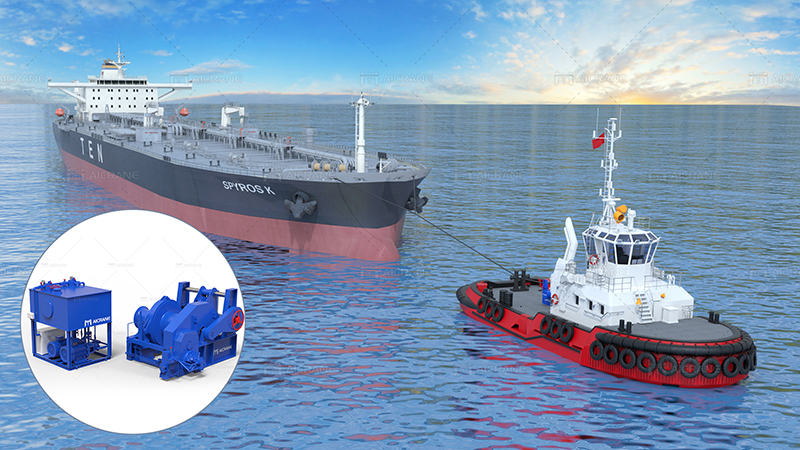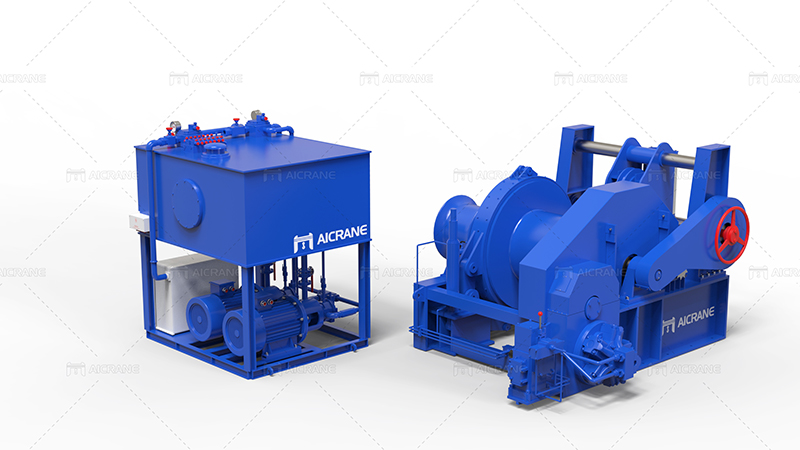In the vast and dynamic world of maritime operations, the role of specialized equipment is crucial to ensuring the safety and efficiency of various tasks. Among these, the marine towing winch stands out as a vital component in towing operations, providing the necessary control and power to navigate the challenges of the open sea. This article aims to delve into the inner workings of a marine towing winch, exploring its components, operation, and significance in the maritime industry.

Components of a Marine Towing Winch
Before exploring the operational aspects, it’s essential to understand the key components that make up a towing winch for sale.
Drum: At the heart of the towing winch is the drum, a cylindrical spool around which the towing line is wound. The drum’s design and size vary based on the winch’s intended use and towing capacity.
Towing Line: The towing line, often a strong and durable steel wire or synthetic rope, is wound around the drum. This line serves as the link between the towing winch and the vessel being towed.
Power System: Marine towing winches can be powered by hydraulic or electric systems. These power systems provide the force necessary for deploying and retrieving the towing line, ensuring controlled and efficient towing operations.
Brake System: A brake system is integrated to control the tension on the towing line and prevent it from free spooling. The brake system is crucial for maintaining stability during towing and for securing the towed vessel.
Control System: The control system is the interface through which operators manage the marine towing winch. It includes levers, buttons, and displays that allow for precise control of line deployment, tension, and retrieval.

Operation of a Marine Towing Winch
Understanding how a marine towing winch operates requires a closer look at the step-by-step process involved in towing operations.
1. Preparing for Towing: Before towing begins, the crew ensures that the towing winch is in proper working condition. This includes checking the integrity of the towing line, inspecting the drum for any damage, and verifying the functionality of the control and brake systems.
2. Deploying the Towing Line: Once the vessel is ready for towing, the towing line is deployed from the drum. This is typically achieved by releasing the brake and activating the power system to unwind the line from the drum.
3. Connecting to the Towed Vessel: The free end of the towing line is then connected to the vessel being towed. This connection is often made through a towline attachment point on the towed vessel, ensuring a secure link between the two vessels.
4. Tension Control: As towing commences, the marine towing winch’s brake system plays a critical role in maintaining the appropriate tension on the towing line. Tension control is essential for stability during towing, preventing sudden jerks or slack that could compromise safety.
5. Monitoring and Adjusting: Throughout the towing operation, operators continuously monitor the tension, speed, and condition of the towing line. Modern marine winches often feature advanced control systems with real-time monitoring capabilities, allowing for precise adjustments as needed.
6. Retrieving the Towing Line: Once the towing operation is completed, the towing line is retrieved by activating the winch’s power system in the opposite direction. The brake system is engaged to control the line’s tension during retrieval, ensuring a controlled and secure process.
7. Post-Towing Inspection: After the towing operation, a thorough inspection of the towing winch and its components is conducted. This includes checking for any signs of wear or damage, lubricating moving parts, and ensuring that the winch is ready for future operations.
Significance of Marine Towing Winches in Maritime Operations
Marine towing winches play a crucial role in various maritime operations, contributing to the safety and efficiency of towing activities. Here are some key aspects highlighting their significance:
1. Safety and Stability: The controlled deployment and retrieval of the towing line, facilitated by the marine towing winch, contribute to the safety and stability of towing operations. The brake system prevents sudden movements, ensuring a smoother and more secure towing process.
2. Versatility: Marine towing winches are designed to handle a range of towing scenarios, from assisting disabled vessels to towing barges or other maritime structures. This versatility makes them essential equipment for a variety of maritime applications.
3. Adaptability to Different Conditions: Towing operations can vary based on weather conditions, sea states, and the type of vessel being towed. Marine towing winches are designed to adapt to these conditions, providing the necessary control and power for successful towing in diverse environments.
4. Precision and Control: The advanced control systems integrated into modern marine towing winches allow for precise control over towing operations. Operators can monitor and adjust tension, speed, and other parameters in real-time, ensuring optimal performance.
5. Efficiency in Emergency Situations: In emergency situations, such as vessel breakdowns or accidents, marine towing winches play a crucial role in quickly and efficiently towing the affected vessel to a place of safety. This contributes to the overall effectiveness of emergency response efforts at sea.
Conclusion
In the intricate dance of maritime operations, the marine towing winch takes center stage, providing the power and control necessary to navigate the challenges of towing at sea. From its fundamental components to the intricate details of its operation, the tugger winch is a testament to the innovation and engineering prowess that define the modern maritime industry. As technology continues to advance, so too will the capabilities of marine towing winches, ensuring that they remain indispensable tools for safe and efficient towing on the world’s oceans.